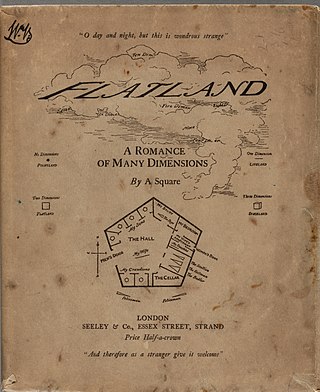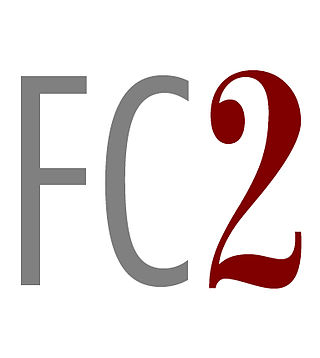
Horror is a genre of speculative fiction that is intended to disturb, frighten, or scare. Horror is often divided into the sub-genres of psychological horror and supernatural horror, which are in the realm of speculative fiction. Literary historian J. A. Cuddon, in 1984, defined the horror story as "a piece of fiction in prose of variable length ... which shocks, or even frightens the reader, or perhaps induces a feeling of repulsion or loathing". Horror intends to create an eerie and frightening atmosphere for the reader. Often the central menace of a work of horror fiction can be interpreted as a metaphor for larger fears of a society.

Flatland: A Romance of Many Dimensions is a satirical novella by the English schoolmaster Edwin Abbott Abbott, first published in 1884 by Seeley & Co. of London. Written pseudonymously by "A Square", the book used the fictional two-dimensional world of Flatland to comment on the hierarchy of Victorian culture, but the novella's more enduring contribution is its examination of dimensions.
Magic realism, magical realism, or marvelous realism is a style or genre of fiction and art that presents a realistic view of the world while incorporating magical elements, often blurring the lines between speculation and reality. Magical realism is the most commonly used of the three terms and refers to literature in particular. Magic realism often refers to literature in particular, with magical or supernatural phenomena presented in an otherwise real-world or mundane setting, commonly found in novels and dramatic performances. In his article "Magical Realism in Spanish American Literature", Luis Leal explains the difference between magic literature and magical realism, stating that, "Magical realism is not magic literature either. Its aim, unlike that of magic, is to express emotions, not to evoke them." Despite including certain magic elements, it is generally considered to be a different genre from fantasy because magical realism uses a substantial amount of realistic detail and employs magical elements to make a point about reality, while fantasy stories are often separated from reality. The two are also distinguished in that magic realism is closer to literary fiction than to fantasy, which is instead a type of genre fiction. Magical realism is often seen as an amalgamation of real and magical elements that produces a more inclusive writing form than either literary realism or fantasy.

Robert Lowell Coover was an American novelist, short story writer, and T. B. Stowell Professor Emeritus in Literary Arts at Brown University. He is generally considered a writer of fabulation and metafiction. He became a proponent of electronic literature and was a founder of the Electronic Literature Organization.
Electronic literature or digital literature is a genre of literature where digital capabilities such as interactivity, multimodality or algorithmic text generation are used aesthetically. Works of electronic literature are usually intended to be read on digital devices, such as computers, tablets, and mobile phones. They cannot be easily printed, or cannot be printed at all, because elements crucial to the work cannot be carried over onto a printed version.
Richard Cory Kostelanetz is an American artist, author, and critic.

Nancy Katherine Hayles is an American postmodern literary critic, most notable for her contribution to the fields of literature and science, electronic literature, and American literature. She is the James B. Duke Distinguished Professor Emerita of Literature, Literature, Trinity College of Arts & Sciences at Duke University.
Derek Alexander Beaulieu is a Canadian poet, publisher and anthologist.

Fiction Collective Two (FC2) is an author-run, not-for-profit publisher of avant-garde, experimental fiction supported in part by the University of Utah, the University of Alabama Press, Central Michigan University, Illinois State University, private contributors, arts organizations and foundations, and contest fees.

Patchwork Girl or a Modern Monster by Mary/Shelly and Herself is a work of electronic literature by American author Shelley Jackson. It was written in Storyspace and published by Eastgate Systems in 1995. It is often discussed along with Michael Joyce's afternoon, a story as an important work of hypertext fiction.

Robert Polito is a poet, biographer, essayist, critic, educator, curator, and arts administrator. He received the National Book Critics Circle Award in biography in 1995 for Savage Art: A Biography of Jim Thompson. The founding director of the New School Graduate Writing Program in New York City, he was President of the Poetry Foundation from 2013–2015, before returning to the New School as a professor of writing.
Stacey Levine is an American novelist, short story author, and journalist. Born in St. Louis, Missouri, she attended the University of Missouri's journalism school and the University of Washington. Her fiction and criticism have appeared in numerous journals, including The Washington [D.C.] Review, Fence, The Iowa Review, Tin House, the Notre Dame Review, The Brooklyn Rail, Bookforum," The American Book Review, Nest-A Journal of Interiors, The Seattle Times, Bookforum, The Stranger, The Seattle Times, and others.

Arthur Allen Cohen was an American scholar, art critic, theologian, publisher, and author.

Clarence Major is an American poet, painter, and novelist; winner of the 2015 "Lifetime Achievement Award in the Fine Arts", presented by the Congressional Black Caucus Foundation. He was awarded the 2016 PEN Oakland/Reginald Lockett Lifetime Achievement Award.

Jennifer Natalya Fink is an American author working in experimental feminist and queer fiction. She is best known for her novels Burn, V, and The Mikvah Queen, which was nominated for the Pulitzer Prize in 2010. Her novel, Bhopal Dance (2018), won the FC2 Catherine Doctorow Innovative Fiction Prize in 2017.
&Now is traveling biennial literary festival and a publishing organization, both focused on innovative literature. The festival's main emphasis is on work that blends or crosses genres and includes a wide variety of work, such as multimedia projects, performance pieces, criti-fictional presentations, and otherwise. The festival seeks out "literary art as it is practiced today by authors who consciously treat their work as a process that is aware of its own literary and extra-literary history, that is as much about its form and materials, language, communities, and practice as it is about its subject matter." Most of the work presented by authors is considered experimental literature.
Marjorie Coverley Luesebrink was an American writer, scholar, and teacher. Writing hypermedia fiction under the pen name M.D. Coverley, she is best known for her epic hypertext novels Califia (2000) and Egypt: The Book of Going Forth by Day (2006). A pioneer born-digital writer, she is part of the first generation of electronic literature authors that arose in the 1987–1997 period. She was a founding board member and past president of the Electronic Literature Organization and the first winner of the Electronic Literature Organization Career Achievement Award, which was named in her honor. Lusebrink was professor emeritus, School of Humanities and Languages at Irvine Valley College (IVC).

Sarah Gerard is an American writer of fiction and nonfiction. She worked for Bomb Magazine. She is the author of three books. The first, a novel, Binary Star, was published in 2015 by Two Dollar Radio. It was a finalist for the Los Angeles Times Art Seidenbaum Award for First Fiction, and was listed as a best book of the year by NPR and Vanity Fair. It received positive reviews in GQ and The New York Times.

VAS: An Opera in Flatland is a novel by the American author Steve Tomasula with design by Stephen Farrell. It was first published in hardback in 2002, and reissued in paperback in 2004. A special “Cyborg” edition, with an audio CD was published in 2009. The novel adapts several characters and settings from Edwin A. Abbott’s novella Flatland: A Romance of Many Dimensions, first published in 1884. Set at the start of the 21st century when technologies like cloning, transplants, and other body modifications were becoming common, VAS employs a wide range of historical representations of the body from family trees and eugenic charts to visual representations of genetic sequencing. Bound in a cover that resembles human skin, the novel is printed in two colors, one that resembles flesh and one that resembles blood. It explores how definitions of the body and the self both emerge from differing narratives, and tells the story of people searching for a sense of identity in a dawning post-biological future.













